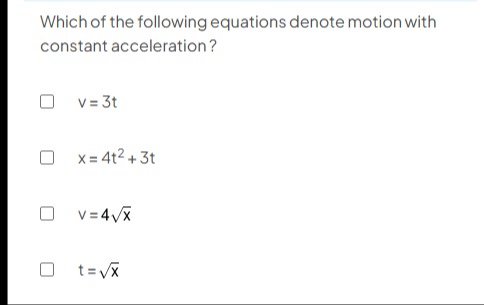Question
Question: Which of the following equations denote motion with constant acceleration? $\square$ v = 3t $\squa...
Which of the following equations denote motion with constant acceleration?
□ v = 3t
□ x = 4t2 + 3t
□ v = 4x
□ t = x

v = 3t
x = 4t2 + 3t
v = 4x
t = x
All of the above
Solution
To determine which equations denote motion with constant acceleration, we need to find the acceleration (a) for each equation and check if it is a constant value (independent of time, position, or velocity).
Recall the definitions:
- Velocity: v=dtdx
- Acceleration: a=dtdv=dt2d2x
- Alternatively, a=vdxdv
Let's analyze each option:
1. v=3t This equation gives velocity as a function of time. To find acceleration, differentiate v with respect to t: a=dtdv=dtd(3t)=3 Since a=3 (a constant), this equation represents motion with constant acceleration.
2. x=4t2+3t This equation gives position as a function of time. First, find velocity by differentiating x with respect to t: v=dtdx=dtd(4t2+3t)=8t+3 Now, find acceleration by differentiating v with respect to t: a=dtdv=dtd(8t+3)=8 Since a=8 (a constant), this equation represents motion with constant acceleration.
3. v=4x This equation gives velocity as a function of position. We can use the formula a=vdxdv. First, find dxdv: v=4x1/2 dxdv=dxd(4x1/2)=4⋅21x(1/2)−1=2x−1/2=x2 Now, calculate acceleration: a=vdxdv=(4x)⋅(x2)=8 Since a=8 (a constant), this equation represents motion with constant acceleration. Alternatively, squaring both sides of v=4x gives v2=16x. This is of the form v2=u2+2a(x−x0), which for u=0,x0=0 becomes v2=2ax. Comparing v2=16x with v2=2ax, we get 2a=16, so a=8.
4. t=x This equation gives time as a function of position. It's easier to first express position (x) as a function of time (t). From t=x, we square both sides to get x=t2. Now, find velocity by differentiating x with respect to t: v=dtdx=dtd(t2)=2t Now, find acceleration by differentiating v with respect to t: a=dtdv=dtd(2t)=2 Since a=2 (a constant), this equation represents motion with constant acceleration.
All four given equations represent motion with constant acceleration.
